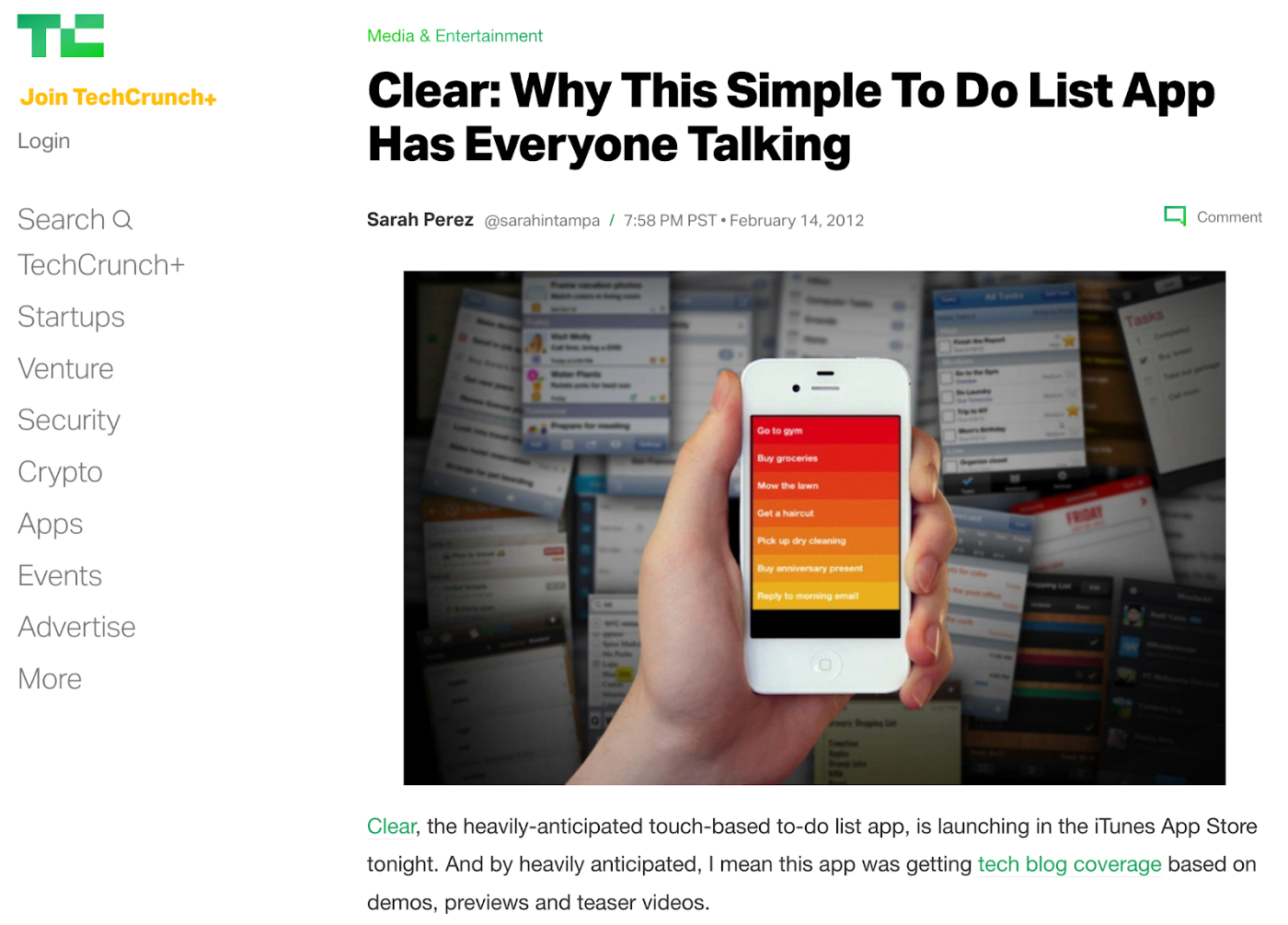
One day 10 years ago I stood in an hour-long line outside an ice cream shop near Dolores Park in San Francisco, and at the end I was greeted with options such as “black sesame” and “balsamic strawberry.” Apparently this place was known for its unique flavors. The good news is that the balsamic strawberry ice cream was delicious. The bad news is that it planted an idea about competitive differentiation in my head that clouded my thinking for years.
I consider myself a creative guy—I get excited about clever food, art, apparel, architecture, music, packaging, writing, and so on. But because I make software, I have a special place in my heart for clever apps. Unfortunately, though, they usually don’t make great businesses. The older I get, the more I appreciate the merits of vanilla software. There is money to be made in boring.
What is flavored software?
Software that attempts to be different in a way that creates temporary excitement, but doesn’t create lasting value, is what I call “flavored software.” Of course, no one thinks this is what they’re building. They think their unique twist is a revolution, and that everyone will adopt their innovation in the future. But sadly, more often than not, they’ve invented the software equivalent of balsamic strawberry ice cream.
The agonizing thing about balsamic strawberry is that it’s actually good. You show it to users and they’re like, “Wow, tasty!” But because it’s software and not ice cream, it’s less obvious that it’s never going to beat vanilla. These apps can even grow substantially if the new flavor is good enough, but they often have trouble sustaining growth.
Product categories that tend to be flavor-based include podcast apps, notes apps, and to-do list apps. I have no disrespect for creators of products in these spaces, so I won’t reference specific names. But for each category, I'll talk about why I think products in it tend to hit early growth asymptotes. Then I’ll extract some general principles for distinguishing between mere flavor differentiation versus scalable value. As a bonus, I’ll pick a few current ideas that seem huge but I predict are just the flavor of the month (sorry, AI avatar makers, I’m looking at you 🥲).
One caveat: this analysis only applies if you want to build a VC-style business that might go public or have a significant exit. If you want to build something awesome and make enough money to live a great life, feel free to disregard it. There is a lot of joy (and cash) to be had by selling balsamic strawberry ice cream, as long as you keep your costs low and don’t raise money from investors who are expecting you to disrupt vanilla.
Example 1: Podcast apps
There are a lot of great podcast apps out there. Unfortunately none of them are great businesses. These two facts are linked.
It’s relatively easy to make a podcast app. You can scrape Apple’s directory and instantly have a library full of all the content any user could want. As a result, developers have created a cornucopia of fun new ways of listening to podcasts. Some apps have custom playlists, others focus on discovery, and there are even some that have created custom audio engines to make the podcasts sound better. Even design details, like the home screen as a beautiful grid of podcast art from your favorite shows, can be enough to capture the hearts of tens of thousands of users.
None of these apps has achieved significant market share, except those that leverage pre-existing power from an adjacent domain—like Apple’s control over the iPhone and Spotify’s popular music app—to grow their podcast user base.
So why haven’t any of the smaller podcast apps been able to discover features that propel them past their initial niche? For three reasons:
- When they do discover a feature that is not just a “flavor of the month” thing (like speeding up audio), it gets copied by every other app.
- Most features they discover are only interesting to a subset of users or are only mildly useful, and not enough to get people to switch from an app they’re used to.
- A great feature is not the same thing as a great growth engine (aka marketing channel), and the types of founders that are focused on the former tend to neglect the latter.
(These ideas are applicable across all categories, not just podcast apps.)
Example 2: Notes apps
Most notes apps like to pretend they are defensible because they have “switching costs”: they think you’ll be reluctant to leave once you fill them up with notes. But in practice, there isn’t much evidence that this is true. In fact, I would argue the opposite: there is a subculture of people who are note-taking enthusiasts, and actively enjoy switching apps and trying new flavors. (To learn what drives this behavior, I recommend reading Dan Shipper’s essay, “Dopamine Stacking.”)
Coming to market with a strawberry balsamic note-taking app and then getting sad when your users churn is like being the frog that let the scorpion ride on its back across the river:
I can hear some of you wondering, “But wait, isn’t Lex kind of like a notes app?” (Lex is the AI-native word processor I’m building.) It’s a reasonable question. That’s the main reason I’m writing this essay—this is a very real risk for Lex, and I want to understand it better. If you’re interested in how I think about it, read to the end.
Example 3: To-do list apps
I’ll name a name in this category because it’s an old app that was universally beloved in its time.
Does anyone else remember Clear??
My god what a beautiful product! If Jiro dreamed of to-do list apps instead of sushi, he would probably make something like this.
In the grand scheme of things, the Clear team probably did alright, but it’s safe to say they did not revolutionize to-do lists forever. It turned out to be more of a cronut-type of situation.
To-do list apps face the same challenges that podcast and notes apps do, with the additional challenge of competing with enterprise project management systems. It’s nice to have a simple place to keep your personal tasks, but most of your work is probably flowing through a larger enterprise system like Notion, Asana, Jira, Linear, or a similar product. These are tough to compete with because they have network effects (you have to use what everyone else in your company uses), and unlike consumer apps, they do actually have switching costs (it’s much harder to move a group of people than to try something new for yourself).
Other flavor-based categories
Other categories that tend to attract flavor-based competition are:
- Email clients
- Read-it-later/RSS reader apps
- Food tracking apps
- Personal finance/stock-tracking apps
- AI avatar apps
- Weather apps
- Habit-tracking apps
- Calculator apps
- Photo-editing apps
Notice something in common? They all feed off of a resource that is either widely accessible or easily recreated. The Gmail API makes it easy to build an email app, the AccuWeather API makes it easy to build a weather app, Stable Diffusion makes it easy to build an AI avatar app, every programming language comes with math functions built-in, you can easily get access to people’s photos from Apple or Google, etc.
To be clear, sometimes scalable businesses do emerge from categories that are usually fragmented and flavor-based. My point is that it’s rare.
Warning signs
Be wary of software with certain characteristics, especially if they’re used together:
- Uses gimmicky and/or clever feature names (e.g., “The Imbox” from HEY)
- Has prominent graphics or animations only because it looks cool, not because they explain or make information more meaningful
- Uses game-like elements to encourage repeat behavior
- Leans hard on in-app copy to make users feel an emotional connection with the software
Side note: every time I see software that is trying a little bit too hard with their copy, it reminds me of this iconic moment in movie history:
What about media?
Media—books, music, games, movies, etc.—is flavor-based, but it’s worth considering separately from software because most media companies are designed to churn out a steady stream of new stuff, whereas most software companies create one thing and then keep polishing and extending it. If software is about “stock,” media is about “flow.”
Some software companies have tried to release new apps—a company called Not Boring (not to be confused with Packy McCormick’s newsletter) is executing this strategy pretty well—but it generally doesn’t work as well as it does in media because there’s a much smaller audience of people that wants to continually try new software than people who want to continually consume new content.
What about CPG?
Consumer packaged goods (CPG) like food, drinks, and toiletries are clearly flavor-based. But they tend to work a bit better as businesses than flavor-based software because, like media, they’re consumable: when you use them, they run out, and you need to buy more. The only difference is people are more likely to keep buying the same unique type of hand soap or whatever for a long time, whereas with media once you’ve consumed a thing you’re unlikely to consume it again. And because there are hard marginal costs associated with manufacturing and distribution, the price never goes all the way to zero in the way that it often does with software or media.
How to escape flavor-based competition
Let’s say you’re building a software company, and you’d like it to be venture-backable. Or perhaps you’re an investor who is responsible for allocating capital into new technology ventures. How can you tell if a software company is going to be more like strawberry balsamic ice cream or Google?
Here are a few guidelines:
- Enterprise software is (mostly) not flavor-based. Sure, there are enterprise fads like the metaverse, but generally speaking, large companies only sign contracts when it feels like there is an obvious commercial advantage to doing so.
- Networks are (mostly) not flavor-based. If you’re using an app because of the content created by its other users, it’s not necessarily a guarantee for success, but at least if it fails it probably won’t be because it hit a flavor-based asymptote. For instance, BeReal leveraged a unique flavor of photo sharing to build a network, but people are still using it because they like the way it helps them stay in touch with their friends. If it were just a single-player utility, it would not have scaled in the same way. Another historical example is Instagram versus Hipstamatic. Both had a cool new flavor called “photo filters,” but one had a network and the other did not. Here’s a more recent example: the network is what sets Substack stands apart from its flavor-based competition.
- Tech-enabled services are not flavor-based. If you act like a tech company but really do grocery delivery, banking, education, housing, healthcare, or any other real-world service, your competition is mostly not flavor-based because starting this type of business involves a lot of cost and complexity. (Also, some, like ride hailing and delivery, are networks.) The downside is that your cost structure is probably not as great as pure tech companies, but the upside is that you have less competition.
All of these types of products can involve some flavoring to help them get off the ground. The point is not that flavoring is bad. It’s good! But it has a very specific role. Flavor provides an initial product wedge. It’s helpful for standing out initially but doesn’t provide long-term differentiation or durable advantage.
Postscript: What about Lex?
Lex is an AI-powered word processor that I’m building. Its initial traction is based on the unique flavor of the way that it feels to write in it, which could be a red flag. But over the long run, Lex might be able to sustain value in a couple of ways:
- Vertical focus. Right now Lex seems like a general-purpose AI writing tool. But over time it will become more obvious that there is a subset of writing that deserves a specific tool. For example, it used to be the case that software UI designers used a design tool (Photoshop) that was made for photo editing; I think we’ll look back on today’s writing apps, like Google Docs, as similarly broad.
- Network. For creative tools, an industry tends to consolidate on a standard way of doing things. Programmers use git partially because all the other programmers use it. Designers use Figma partially because all the other designers use it. I think the same can happen for writing.
This is all very speculative and early, though, so my approach is to just focus on shipping improvements to the product as quickly as possible. In order for anything else to matter, Lex has to be a great tool first.
The Only Subscription
You Need to
Stay at the
Edge of AI
The essential toolkit for those shaping the future
"This might be the best value you
can get from an AI subscription."
- Jay S.
Join 100,000+ leaders, builders, and innovators

Email address
Already have an account? Sign in
What is included in a subscription?
Daily insights from AI pioneers + early access to powerful AI tools










Comments
Don't have an account? Sign up!
May I join the Lex beta?
Regards, David